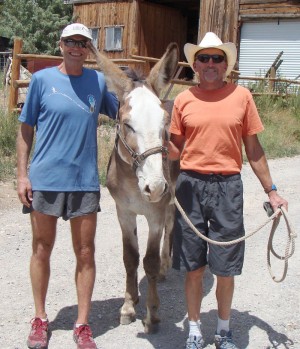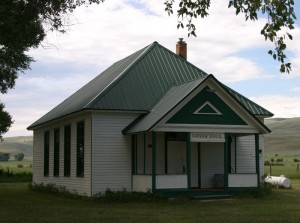By George Sibley
Part 2: The Quest for the Rational versus the Irrational and – Immortal?
Lying astride the Continental Divide, Central Colorado has been a crossroads for some action and a lot more “discussion” concerning the state’s central problem: an arid region with 90 percent of its people on one side of the Divide, and around 80 percent of its water on the other side. The Fryingpan-Arkansas Project, celebrating the 50th anniversary this year of its “creation on paper,” is one of Colorado’s solutions to that problem, moving water from the West Slope through the Divide to the Arkansas River Basin. This second part of the story details how the Fryingpan-Arkansas Project came to be.
1937 was a seminal year in Colorado’s water history – not because of any dams or canals that suddenly appeared on the landscape, but because in that year so much of the political and legal infrastructure underlying water development in Colorado clicked into place.
In that one year, the Colorado General Assembly:
• Passed a Water Conservancy Act, enabling ditch companies, irrigation districts, and other water-user associations to form quasi-municipal “water conservancy districts” with general taxing powers, in order to issue revenue bonds, or, more usually the case, contract directly with the Bureau of Reclamation, to pay for water projects.
• Created the Colorado River Water Conservation District, a legally constituted improvement on the “Western Colorado Protective Association” described in last month’s installment. This organization had taxing power to represent West Slope water users in interactions with the East Slope, and also to organize conservancy districts as described above in order to develop water projects on the West Slope.
• Created the Colorado Water Conservation Board (CWCB), a body with representatives from all of the major river basins in Colorado to coordinate the development of the state’s water resources and to resolve disputes between the East and West Slopes.
A direct result of this evidence is that the people of Colorado were beginning to transcend their regional contention. The United States Congress appropriated money that same year to launch the “Colorado-Big Thompson Project,” a huge complex of reservoirs, canals, conduits and tunnels to bring up to 310,000 acre-feet of water from the upper Colorado River to the farmers of the South Platte Basin, who had quickly organized the Northern Colorado Water Conservancy District.
A number of “unsung heroes” – seldom acknowledged today – put together this remarkable “confluence” of legislation. Greeley newspaper publisher Charles Hansen led the South Platte team of farmer J.M. Dille and lawyers William Kelly and Thomas Nixon. Their protagonists from the West Slope were all attorneys: D.W. Aupperle and Silmon Smith from the Grand Valley (both also farmers on the side), rancher-lawyer Frank Delaney from Glenwood Springs, and three county judges from the Gunnison Basin, Dan Hughes (Montrose), Milton Welch (Delta), and Clifford Stone (Gunnison). Stone, in his first and only term in the state House, carried both the CWCB and River District bills, and collaborated in authoring the Conservancy District Act.
State Planning Director Edward Foster also played an important role, as did Governors Ed Johnson and Teller Ammons. And looming over it all was a 15-term Congressman, Edward Taylor, who had the power in Congress to declare that there would be no federally funded trans-mountain water diversions to the East Slope without adequate “compensatory storage” for the West Slope. But Taylor was 80 in 1938, and West Slope water users knew that kind of protection would have to be made systemic or institutional before Taylor left office, or the West Slope would have no protection at all.
Two Bureau of Reclamation engineers were also critical players, one from each side of the Divide: Porter Preston from the Upper Colorado Region and Mills Bunger from the Great Plains Region. They helped author the key document that enabled congressional approval of the Colorado-Big Thompson Project: a “Manner of Operation of Project Facilities and Auxiliary Features” in “Senate Document 80,” a Bureau document that described the whole project for Congress. The “Manner of Operation” section laid out in detail how the East Slope obligation to the West Slope basin of origin was to be carried out, at South Platte expense, through the construction and operation of a 154,000 acre-foot Green Mountain Reservoir, Dam and Powerplant on the Blue River, a headwaters tributary of the Colorado River. This facility would store spring-flood water for release into the Colorado River through the summer – flood waters that had previously passed through the state and down to California and the ocean by early summer. And two-thirds of the reservoir was dedicated for future growth and development on the West Slope.
Arkansas Basin water users – facing the same late-summer water shortages as the South Platte irrigators, as well as the “Dust Bowl” drought – had been looking longingly across the Divide to the Gunnison Basin for decades, and thought it was their turn next.
They were supported in that hope by the first director of the new Colorado Water Conservation Board, Clifford Stone – an attorney from Gunnison, but also a man with a large vision for the unwieldy political abstraction called Colorado. Judge Stone believed that through rational dialogue and a principle of mutual equity, like the discourse that had finally emerged in 1936 and 1937 between the West and East Slopes on the Colorado-Big Thompson Project, Colorado would be able to develop its fair shares of all the rivers that rose in the state and also meet downstream obligations to other states. From 1937 until his death of heart failure at a 1952 water meeting, he quite literally gave his life to developing the interstate compacts and intrastate agreements that would “rationalize” the natural and cultural imbalances and inequities of water distribution under an arid climate and a first-come, first-served body of water law.
What he didn’t know was how hard it was going to be to reach that kind of human awareness and cooperation, but he learned that pretty quickly when he set about trying to replicate the northern Colorado success in southern Colorado.
Despite (or maybe because of) the severe drought in southeastern Colorado, the Arkansas Valley water users were not so aggressive or organized as those in the South Platte. But a major trans-mountain diversion from the Gunnison Basin had always been on the “wish lists” composed by Edward Foster’s State Planning Commission, and the Arkansas Basin’s Congressman John Martin had aggressively sought funding for a Bureau of Reclamation study of such a project. But Martin lacked the seniority and power of West Slope Congressman Edward Taylor, the chairman of the House Appropriations subcommittee that controlled the Interior Department budget. Taylor easily eliminated such funding requests until they were accompanied by an assurance of adequate compensatory storage for the West Slope basin of origin.
Following the creation of the Colorado Water Conservation Board, however, the attorney for an Arkansas Valley Ditch Association, Judge A.W. McHendrie, saw the CWCB as a new route to the development of a Gunnison-Arkansas trans-mountain diversion project. In December 1937, with the CWCB newly created, he invited Judge Stone to meet with the Ditch Association – before Stone was even officially appointed CWCB Director. Judge McHendrie expressed complete willingness to accept Senate Document 80 as a model for creating such a project: the Arkansas Basin would get the West Slope water it desperately needed, and the Gunnison Basin would get, at the Arkansas Basin’s expense, some of the storage it needed to keep the Gunnison’s water from running off to California by mid-June every year.
Encouraged by that acceptance of the main condition indicating the intrastate harmony required for federal funding and Bureau construction, Stone set a January 1938 meeting in Gunnison to discuss an equitable trans-mountain project, but ran into a buzz saw in his own hometown. Five hundred people showed up for the meeting. Stone’s purpose for the meeting was just to make the case for a thorough study of water availability for present and future Gunnison Basin needs, to see if there was a surplus for the East Slope, as had been done for the Colorado-Big Thompson Project. What he found was a populace so vigorously opposed to the idea of trans-mountain diversion that they didn’t even want a study to commence, believing that the Bureau would manipulate the numbers to show water availability where there might be none.
Leading the charge in the Upper Gunnison was Henry Lake Jr., publisher of the Gunnison News-Champion. Immediately after Stone’s visit, Lake wrote an editorial simply titled simply “NO,” in an attempt to rouse the citizenry.
He wrote, “The lifeblood of the Gunnison Country is water. Its beauty, its industry, its future depend upon the marvelous river flowing past our city. Yet we are asked to even consider the loss of that beautiful stream and all it means, to acquiesce in a survey to determine whether it may be diverted to enrich a far off land and leave us high and dry.”
Stone had not advocated anything that would leave the Upper Gunnison “high and dry,” and his reminder, that legally there was nothing to prevent the Arkansas Basin water users from simply coming over and appropriating unused Gunnison River water, fell on deaf ears. Lake put complete confidence in Congressman Taylor’s ability to stop anything his constituents did not want. Lake said, “Congressman Taylor is with us.”
Gentle reminders that Taylor was an old man by then, in marginal health (he had been hospitalized when the Colorado-Thompson Project bill was debated), and his protection for the West Slope would leave with him, also fell on deaf ears. For most West Slope people, Congressman Taylor had been in office for as long as they had been politically aware, leading Lake to observe editorially at one point, “Some day in the future it is claimed Congressman Taylor may not be with us … What foolishness! Congressman Taylor in a letter of Feb. 21 states that ‘I am pleased to say that my health is quite good and I am coming along as nicely as I can expect.’”
Having affirmed his belief in the immortality of his congressman, Lake also dismissed as “not worth a damn” the CWCB (“an eastern slope water board”), the Colorado River District (frequently confused, maybe inadvertently, with the CWCB), the Delaney Resolution and Senate Document 80.
Lake and other galvanized Upper Gunnison water users like attorney Ed Dutcher and rancher Craig Goodwin fanned the flames to Montrose and Delta counties down the river, generating an uproar that brought Taylor, like the deus ex machina from a Greek drama, to minister to his flocks. He praised their enthusiasm, but told them that, rather than “not one drop” resolutions, he needed factual information about the water supply and their own future needs in order to effectively stand against a trans-mountain diversion – exactly the information that Stone’s study would have generated, and the River District was intended to provide.
But Taylor never mentioned the CWCB or the River District, charging the local county commissioners to find the money to gather the information. This led Lake to the notion of going to the Colorado River District – not to ask them to get about their mission and direct such a study, but to ask for the return of Gunnison Basin’s tax dollars so they could do it themselves. Stone and the River District board opposed this vigorously, assuring them that as soon as the River District had a Secretary-Engineer, his first duty would be to undertake the study on behalf of the people of the West Slope.
In retrospect, Stone had probably erred in moving too fast to try to work out a good deal for both the Arkansas and Gunnison basins. When the Upper Gunnison erupted, the River District did not yet have the staff or procedures in place to oversee a Bureau study, although a Bureau engineer who had been working for years on the West Slope, Frank Merriell, had been hired to start with the District in August 1938.
Stone made several other visits to the Upper Gunnison, attempting damage control. Noting an “undue excitement” over the idea of merely doing a “first or preliminary study,” he observed that “some of the statements that have come out of Gunnison seem to me to hit below the belt.” He conceded the importance of preserving the sport fisheries of the Upper Gunnison as well as the more traditional utilitarian uses of water, and promised that the study would take such economic benefits into account.
On one of his oil-on-troubled-water visits, he brought the State Engineer along to point out that the mountain ranchers irrigating the alluvial valleys could probably demonstrate the historic use of considerably more water for irrigation than the standard Colorado “duty of water” (one cubic foot per second for every 40 acres). He encouraged them to install accurate measures, and promised state help in getting the duty of water for deep alluvial valleys raised to three or four cfs per 40 acres. That was done in 1941 and 1943 – both protecting the mountain ranchers, and also significantly reducing the amount of upper-basin water that might be available for trans-mountain diversion.
But his efforts were to no avail. The Upper Gunnison people, constantly harangued by Lake, stayed totally opposed to a study – and were reinforced in that by their congressman, who, whether he himself believed he was immortal or not, conceded nothing to Stone on the need for a legal and political infrastructure in place mandating compensatory storage after Taylor’s large thumb was removed from the Interior Department’s budget. Some more farsighted minds in the Gunnison Basin did see that need – but reacted by suggesting that the Gunnison Basin needed an organization of its own, something like, well, a conservation district, like the one “on the northern Colorado River.”
That idea led Frank Merriell, the River District’s new Secretary-Engineer, to observe that “so long as Congressman Taylor lives they do not need [such an organization], and when he is gone, any efforts to fight the diversion will be entirely fruitless.”
Meanwhile, the people of the Arkansas Basin waited – not patiently, but resigned to waiting out the West Slope’s congressman. And that worked out as Merriell had predicted. In 1941, Congressman Taylor died in office in his 17th term in the House. And he was barely in the ground before an appropriation for a Gunnison-Arkansas Project study emerged.
The Second World War stopped most water project work for the duration (although the Colorado-Big Thompson work went on, albeit more slowly, for both the food production and hydropower it would generate). But after the war, the Bureau of Reclamation finished its study of the Gunnison Basin and came out in 1948 with plans for a Gunnison-Arkansas Project. A big Gunnison-Arkansas Project. Next month, we’ll see how that eventually became the (somewhat smaller) Fryingpan-Arkansas Project.
George Sibley of Gunnison is currently at work on a history of the Colorado River District and Colorado water development.



